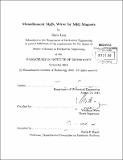Monofilament MgB₂ wires for MRI magnets
Author(s)
Ling, Jiayin
DownloadFull printable version (10.58Mb)
Alternative title
Monofilament MgB₂ wires for Magnetic Resonance Imaging magnets
Other Contributors
Massachusetts Institute of Technology. Dept. of Mechanical Engineering.
Advisor
Yukikazu Iwasa.
Terms of use
Metadata
Show full item recordAbstract
MRI magnets are useful medical devices in early detection and efficient treatment of disease or injury. Because of the significant better performance, MRI magnets are made of superconductors rather than made of copper. Nowadays, there are over 20,000 superconducting MRI magnets installed worldwide. Most of them are made of NbTi or Nb₃Sn, but they are usually very expensive to purchase or operate. So, my colleagues chose MgB₂ wires to develop low-cost and easy-to-operate MRI units which serve to the majority of the humanity. Because we have a reliable technology to fabricate superconducting joints with monofilament MgB₂ wire, we decided to build our MgB₂ MRI magnet with monofilament wire instead of multifilament wire. Previously, flux jumping was found to be the main issue with monofilament superconducting wire; we have to demonstrate that flux jumping is not a big issue with monofilament MgB₂ wire before we can build our MRI magnet with it. In this thesis, a series of experiments was designed and carried out to prove that the monofilament MgB₂ wire performs as well as the multifilament MgB₂ wire in MRI magnet applications. Short samples of monofilament MgB₂ wires were tested, and magnetization trace of the short samples showed that flux jumping could be a minor issue with monofilament MgB₂ wire. Three 100-m sample coils made of multifilament MgB₂ wire, monofilament MgB₂ wire, and monofilament NbTi wire were wound, tested and compared. The results of these tests demonstrated that the monofilament MgB₂ wire has insignificant flux jumping which does not lead to a premature quench. So, monofilament MgB₂ wire is potentially a good option for MRI magnets.
Description
Thesis (S.M.)--Massachusetts Institute of Technology, Dept. of Mechanical Engineering, 2012. Cataloged from PDF version of thesis. Includes bibliographical references (p. 85-86).
Date issued
2012Department
Massachusetts Institute of Technology. Department of Mechanical EngineeringPublisher
Massachusetts Institute of Technology
Keywords
Mechanical Engineering.